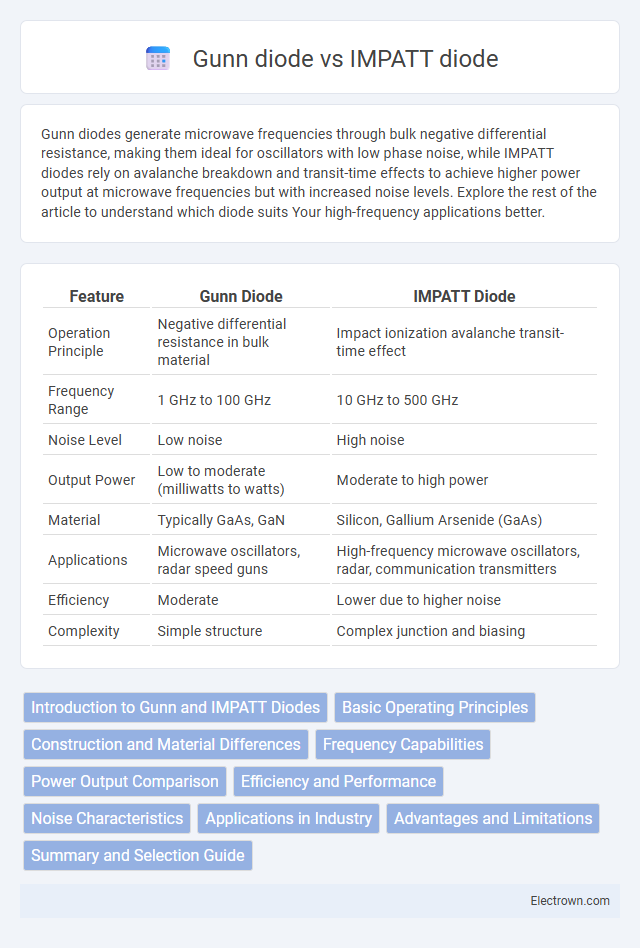Gunn diodes generate microwave frequencies through bulk negative differential resistance, making them ideal for oscillators with low phase noise, while IMPATT diodes rely on avalanche breakdown and transit-time effects to achieve higher power output at microwave frequencies but with increased noise levels. Explore the rest of the article to understand which diode suits Your high-frequency applications better.
Table of Comparison
| Feature | Gunn Diode | IMPATT Diode |
|---|---|---|
| Operation Principle | Negative differential resistance in bulk material | Impact ionization avalanche transit-time effect |
| Frequency Range | 1 GHz to 100 GHz | 10 GHz to 500 GHz |
| Noise Level | Low noise | High noise |
| Output Power | Low to moderate (milliwatts to watts) | Moderate to high power |
| Material | Typically GaAs, GaN | Silicon, Gallium Arsenide (GaAs) |
| Applications | Microwave oscillators, radar speed guns | High-frequency microwave oscillators, radar, communication transmitters |
| Efficiency | Moderate | Lower due to higher noise |
| Complexity | Simple structure | Complex junction and biasing |
Introduction to Gunn and IMPATT Diodes
Gunn diodes are semiconductor devices based on the transferred electron effect in materials like GaAs and GaN, primarily used for microwave frequency generation due to their negative differential resistance. IMPATT diodes utilize avalanche breakdown and transit-time effects in materials such as silicon and gallium arsenide to produce high-power microwaves at frequencies ranging from 3 GHz to 100 GHz. Both diodes are key components in microwave oscillators, but Gunn diodes operate with simpler structures while IMPATT diodes offer higher power output and efficiency in millimeter-wave applications.
Basic Operating Principles
Gunn diodes operate based on the transferred electron effect in a single semiconductor material, producing microwave oscillations without a p-n junction, ideal for high-frequency generation. IMPATT diodes utilize impact ionization and avalanche breakdown in a p-n junction to generate high-power microwave signals with phase shifts that enhance oscillation efficiency. Your choice depends on desired frequency range and output power, as Gunn diodes excel in low-noise applications, while IMPATT diodes offer higher power at microwave frequencies.
Construction and Material Differences
The Gunn diode is constructed primarily from n-type Gallium Arsenide (GaAs) or Indium Phosphide (InP), utilizing a simple two-terminal structure without a PN junction, relying on bulk material properties for operation. In contrast, the IMPATT diode incorporates a PN junction with materials like Silicon (Si) or Gallium Arsenide, designed to exploit avalanche multiplication and transit-time effects for high-frequency generation. Understanding these material and structural differences helps you select the appropriate diode for applications requiring specific frequency ranges and power levels.
Frequency Capabilities
Gunn diodes typically operate efficiently within the microwave frequency range of 1 to 100 GHz, making them suitable for applications such as radar and communication systems. IMPATT diodes can generate frequencies extending from microwave bands up to millimeter-wave frequencies, often reaching beyond 100 GHz with higher power output. The superior frequency capabilities of IMPATT diodes make them ideal for high-frequency radar, satellite communication, and other advanced high-frequency applications.
Power Output Comparison
Gunn diodes typically deliver lower power output, generally in the range of a few watts, suitable for microwave applications up to a few GHz. In contrast, IMPATT diodes can achieve significantly higher power levels, often tens to hundreds of watts, making them ideal for high-power microwave generation in radar and communication systems. Your choice between the two should consider the required power output and frequency range, as IMPATT diodes excel in high-power, high-frequency scenarios.
Efficiency and Performance
Gunn diodes offer moderate efficiency with low noise and are commonly used in microwave oscillators operating at frequencies up to 100 GHz. IMPATT diodes, while less efficient due to higher noise levels and power dissipation, deliver higher power output and can operate at millimeter-wave frequencies beyond 100 GHz. Your choice between these diodes depends on whether you prioritize low noise and moderate power (Gunn) or high power output at very high frequencies (IMPATT).
Noise Characteristics
Gunn diodes exhibit low noise characteristics due to their electron transit-time mechanism, resulting in stable microwave signal generation with minimal phase noise. IMPATT diodes generate higher noise levels because of avalanche multiplication and ionization processes that introduce significant phase and amplitude fluctuations. Choosing between these devices depends on your application's noise sensitivity, with Gunn diodes preferred for low-noise microwave oscillators.
Applications in Industry
Gunn diodes are widely used in microwave oscillators and amplifiers within radar systems and communication devices due to their ability to generate high-frequency signals efficiently. IMPATT diodes, known for higher power output and operation at microwave and millimeter-wave frequencies, are integral in applications like satellite communication, automotive radar, and high-speed wireless networks. Your choice between these diodes depends on the required frequency range, power levels, and phase noise performance in industrial RF and microwave applications.
Advantages and Limitations
Gunn diodes offer advantages such as highly stable microwave frequency generation, low noise operation, and simpler fabrication compared to IMPATT diodes. However, their lower power output and limited frequency range pose significant limitations. IMPATT diodes provide higher power levels and operate effectively at millimeter-wave frequencies but suffer from higher noise levels and thermal management challenges.
Summary and Selection Guide
Gunn diodes operate using negative differential resistance in a bulk semiconductor, making them ideal for low-noise microwave oscillators with frequencies up to 100 GHz, while IMPATT diodes use avalanche breakdown and transit-time effects to generate higher power at microwave frequencies but with higher noise levels. Your selection depends on application requirements: choose Gunn diodes for stable, low-noise signal generation in radar and communication systems, or IMPATT diodes when higher power output is critical despite increased noise. Key parameters to consider include operating frequency range, output power, noise figure, and thermal management needs.
Gunn diode vs IMPATT diode Infographic

 electrown.com
electrown.com